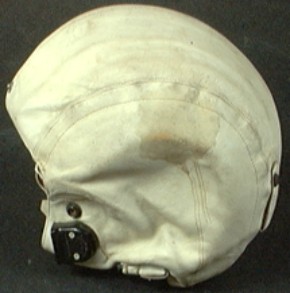Latest update 15 November 2009
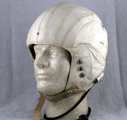
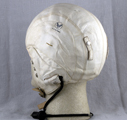
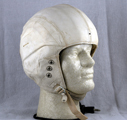

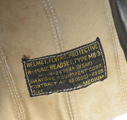
MB-3 helmet. Photos © Bluelight.
Message 1735:
Bones, The MB-2 is identical to the MB-3 only it had an HS-38 Headset (I have never seen
an MB-2 helmet, but there is a Type designation sheet for it. The MB-3 only weighs 28
ounces and the semi-rigid shell was supposed to offer as much protection as the P series
helmet. If you read between the lines in the USAF helmet development effort a couple of
things seem to repeat: Visibility to a fighter Jock is everything, increased helmet Weight
means less Gs, and how do you eject into a 600 MPH wind with losing you helmet? The
Clamshell could withstand the windblast but weighed 7 pounds and had really poor
visibility. It would appear that if you had to pick what was most important, the fighter
jocks wanted lightweight and good visibility which the MB-3 would offer. Keeping it on
after egress seems to be another story.
If you read the USAF test on the HGU-15/P, I think the F-104 jocks (Did I get the right
group Chris) didn't like the helmet because they couldn't wear their sunglasses with it.
The MB-3 concept died hard. I have an HGU-40/P. It's very similiar to the MB-3 only about
20 years later. Personally, I think the fighter jocks just liked the lure of the old
leather helmet, an airplane armed with a gun and/or cannon, and attacking out of the sun,
no RADAR etc. Put another way, Hockey players fought mandatory head gear for years for
probably the same reasons. Can you get with me offline to discuss some of your
documentation. I'd love to include some of your references.
Cheers, FIGMO
Message 1710:
Bones, One of the problems when citing magazine articles, or manufacturers flyers
is that they may not really reflect how long an item was "In Development"
prior to actual use. The USAF MB-1, MB-2, and MB-3 were all spec'd out in the early 50s.
The MB-2 is actually an MB-3 with an HS-38 Headset while the MB-3 was ORIGINALLY the
H-71/AIC which was later chaged and we now know as the A-13A Green leather helmet). The
MB-3 uses the H-149/AIC headset (have seen the MB-3 both ways: pony tail and non ponytail)
.They were designed initially to replace the P series flight helmets. MB-3 type
designation was assigned 18 June 1954. (The San Diego Aerospace Museum has a photo of
Jackie Cochran wearing an MB-3 when she checked out in an F-106. This F-106 reference was
added just to push Carey over the edge).
Cheers, FIGMO
Message 1698:
Greetings all. Sorry the I am a bit late answering this, it has just taken me a while to
go through my e-mil and get my sources. On the MB-3 Helmet. I have noticed that most
people are under the impression that The MB-3 helmet dates from the early 1950's. It was
actually introduced in 1959. I have an article from the March 1959 issue of "Flying
Safety" that states: "The type MB-3 helmet is a light weight semi-rigid helmet
intended for aircrewmen flying long hours and requiring a maximum of comfort. This helmet
is currently undergoing service testing and is anticipated to be available to aircrews
during 1959."
This clearly indicates the date of introduction. Apparently it was intended to replace the
the A-10A. the A-13 and the A-11 helmets. The article also states in the next paragraph:
" the type P-4B helmet is primarily intended for fighter pilots flying a two to three
hour missions and consists of....."There is no mention of the HGU-2/P, even though I
have a 1958 reference to the HGU-2/P
Bones
Message 1642:
Hi Hud, The MB-3 was indeed used in USAF bombers (SAC crews) and a few other large,
multi-engine aircraft in the early 50s. It used a semi-stiff internal construction encased
in leather that provided a degree better protection than completely soft leather or fabric
helmets. The specimen in the image shown is of interest due to its use of one of the
snap-on bayonet type receivers that are rarely seen today (and hard to come by these
days). This helmet was basically reissued later as the well-known 'HALO' helmet that crops
up occasionally on eBay, only the unit is clad in black leather. Whereas the MB-3 used a
headset & comcord assembly like a conventional hard or soft helmet, the later HALO
version usually didn't feature a headset due to difficulties hearing in parachuting
situations (most coms were conducted by visual signal, rather than by electronic
transmission). $200+ in US funds is a bit steep for a well used specimen, but an unused,
pristine or excellently preserved example could command that much, in my opinion. The one
shown looks obviously used, but in reasonably good condition.
Cheers, DocBoink
Message 1637:
Hi all,
Came across a similar helmet in a surplus store over here (Yes Sven in Heukelum). It had a
price tag of $205 US dollar. The example I saw had the white cast receivers. Anybody got
some info on this helmet? I know it is 50's vintage USAF bombers? The image comes from
Manions who have one on auction. Any info is welcome.
Bye HUD
